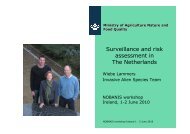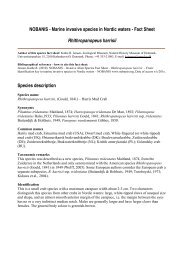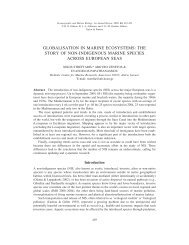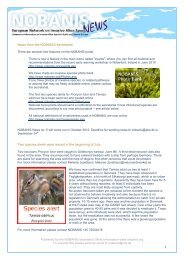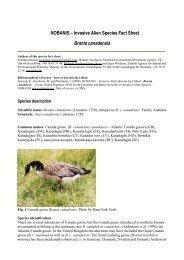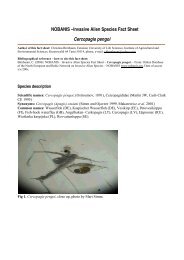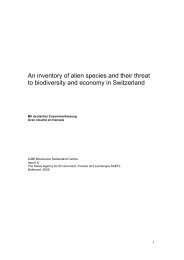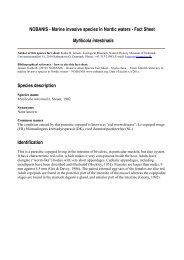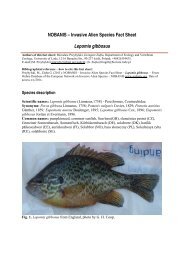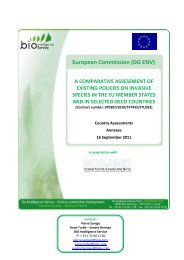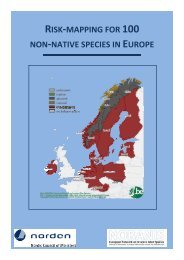Pseudorasbora parva - NOBANIS
Pseudorasbora parva - NOBANIS
Pseudorasbora parva - NOBANIS
Create successful ePaper yourself
Turn your PDF publications into a flip-book with our unique Google optimized e-Paper software.
<strong>NOBANIS</strong> – Invasive Alien Species Fact Sheet<br />
<strong>Pseudorasbora</strong> <strong>parva</strong><br />
Author of this fact sheet: Andrzej Witkowski, Museum of Natural History, Wrocław University, Sienkiewicza 21, 50-<br />
335 Wrocław, Poland; Phone: ++ 48 71 375 41 53, E-mail: a.witkowski@biol.uni.wroc.pl<br />
Bibliographical reference – how to cite this fact sheet:<br />
Witkowski, A. (2011): <strong>NOBANIS</strong> – Invasive Alien Species Fact Sheet – <strong>Pseudorasbora</strong> <strong>parva</strong>. – From: Online<br />
Database of the European Network on Invasive Alien Species – <strong>NOBANIS</strong> www.nobanis.org, Date of access x/x/201x.<br />
Species description<br />
Scientific names: <strong>Pseudorasbora</strong> <strong>parva</strong> (Temminck et Schlegel, 1846) - Cypriniformes,<br />
Cyprinidae.<br />
Synonyms: Leuciscus parvus Schlegel, 1842; L. pusillus Temmnick et Schlegel, 1846; Fundulus<br />
virescens Temmnick et Schlegel, 1846; Leuciscus pusillus Temmnick et Schlegel, 1846; Micraspius<br />
mianowski Dybowski, 1869; Aphiocypris chinensis Fowler, 1924; <strong>Pseudorasbora</strong> altipinna<br />
Nichols, 1925; <strong>Pseudorasbora</strong> fowleri Nichols, 1925; P. depressirostris Nichols, 1925; P.<br />
monstruosa Nichols, 1925; P. <strong>parva</strong> parvula Nichols, 1929; P. <strong>parva</strong> tenuis Nichols, 1929; P.<br />
<strong>parva</strong> Berg, 1949; P. <strong>parva</strong> <strong>parva</strong> Okada, 1960.<br />
Common names: Stone moroco, topmouth gudgeon, false razbora (GB), střevlička východní (CZ),<br />
Blaubandbärbling, Amurbärbling, Pseudokeilfleckbarbe, Asiatischer Gründling (DE),<br />
båndgrundling (DK), Ebarasboora (EE), Rytinis gruzlelis (LT), Amūras čebačeks (LV), czebaczek<br />
amurski (PL), Tschebatchek, Čebačok amurskij (RU).<br />
Fig. 1. <strong>Pseudorasbora</strong> <strong>parva</strong>, photo by Andrzej Kruk.
Species identification<br />
P. <strong>parva</strong> has an elongate body, slightly flattened on sides, resembling that of the species of the<br />
genus Gobio. Maximum size up to 110 mm Tl, though most individuals are 80-90 mm in length and<br />
17.1-19.2 g in body mass. Life span up to 3-4 years.The head is somewhat flattened in its anterior<br />
part. The mouth is clearly in top position. The dorsal and anal fins are short. The caudal fin is big<br />
and deeply incised, with both parts of similar size. The ventral fins are located slightly anterior to<br />
the dorsal fin. The throat is covered with scales. The lateral line is complete, running in the middle<br />
of sides. The scales are large and cycloidal. Number of scales in lateral line (34) 35-38 (39). The<br />
coloration is similar in both sexes, with greay back, light sides and belly, passing from yellowishgreen<br />
to silver. Young individuals have a dark stripe along the body sides; it disappears with age. In<br />
caudal part of the scales pigment forms characteristic lunate spots. The fins are pale, light yellow,<br />
only on the dorsal fin there is a darker stripe, running obliquely backwards (Berg 1949, Kotusz and<br />
Witkowski 1998, Šebela and Wohlgemuth 1984, Witkowski 1991a,b).<br />
The sexual dimorphism becomes pronounced during spawning. In males breeding tubercles appear<br />
on the head. The greatest accumulation of sharp tubercles (ca. 14) is located in the anterior part of<br />
the head, on the frons, near nostrils and below and above the eye. Few tubercles (ca. 4) are observed<br />
also on the lower lip. In that period the males darken distinctly, and their fins become black while<br />
the operculum gets violet. The females become clearly lighter (Anhelt and Tiefenbach 1991, Berg<br />
1949, Movčan and Kozlov 1978, Muchačeva 1950).<br />
Native range<br />
The native range of P. <strong>parva</strong> is the East Asian subregion including the basins of the rivers Amur,<br />
Yang-tze, Huang-ho, Japanese islands (Kiusiu, Sikoku and the southern and central parts of<br />
Honsiu), western and southern parts of the Korean Peninsula and Taiwan (Minkiang river system)<br />
(Bănărescu 1999, Berg 1949).<br />
Alien distribution<br />
History of introduction and geographical spread<br />
In Europe P. <strong>parva</strong> was found in many regions and river systems of Romania, including the Danube<br />
delta, already in the 1960s. It was first recorded in 1961 from southern Romania (fish farm Nucet –<br />
Dimbovita river system) (Bănărescu 1999, Bănărescu and Nalbant 1965) and Albania (Knezevič et<br />
al. 1978). Spreading along the Danube river, the stone moroco was recorded from Hungary in 1963.<br />
It is not excluded that it got there with fry of Ctenopharyngodon idella, Aristichthys nobilis and<br />
Hypophathalmichthys molitrix, imported to several local fish farm. In subsequent years it was found<br />
in most fish ponds and in open waters, including lake Balaton (Biró 1972). In 1972 the species was<br />
recorded from the European part of the former USSR – the Danube delta and Dniester (Kozlov<br />
1974). Bănărescu (1999) is of opinion that in some areas (Volga, Don, Dniester, Neman) it was<br />
introduced much earlier, before 1961. It was probably from Hungary that it penetrated into the<br />
former Czechoslovakia. It was first recorded there in 1974 in the Tisa river catchment area (Žitnan<br />
and Holčik 1976). In Lithuania P. <strong>parva</strong> was introduced accidentally into lake Dunojaus in 1963<br />
when introducing several other herbivorous fish species. However during the recent decades the<br />
species have not been observed in that lake anymore. So the status in Lithuania is unknown<br />
(possibly extinct) (Virbickas 2000). In subsequent years P. <strong>parva</strong> was found in Czechoslovakia in<br />
over 20 sites, including a few near the Polish border (district Karvina) (Wohlgemuth and Šebela<br />
1987). In mid 1970s it was purposefully introduced in France (region of Sarthe) (Allardi, Canceler<br />
1988), and then observed in the Rodan river (Allardi and Keith 1991). In 1982 and subsequent years<br />
the species was recorded from Austria (first in the March and Tulln rivers) (Weber 1984). In 1984<br />
the stone moroco was caught in eastern Gemany in the Weisse Elster river (near Gera) (Arnold<br />
2
1985). Since 1987 this species has established permanent populations in western Germany (Arnold<br />
1990). Using the Main-Danube canal and then the Rhine, it has spread in western Europe where<br />
now it is present (since 1992) in Belgium and the Netherlands (Golzan et al. 2002, Pollux and<br />
Korosi 2006). In these areas (Germany, Benelux) is has probably spread as a result of private<br />
stocking/introductions as well, because it is often kept in ponds and sold as ornamental fish or bait<br />
fish, (S. Nehring, pers. comm.). In the 1970s and 1980s it was found in Bulgaria, northern Greece,<br />
Turkey and in the western part of the Balkans (Serbia and Montenegro) - in lakes Skardar, Prespa,<br />
Ohrida and in Aliakmaon river (Bianco 1988, Erk’akan 1984, Jankovic and Karapetkova 1992,<br />
Rosecchi et al. 1993, Wildekamp et al. 1997). In Poland P. <strong>parva</strong> was recorded for the first time as<br />
late as 1990; it got there with stocking material of carp, imported in the 1980s, probably from<br />
Hungary (Witkowski 1991a,b). In subsequent years (till 2000) the species was recorded from most<br />
lowland rivers of Poland (Witkowski 2002). In recent few years the stone moroco was found also in<br />
northern Italy (Bănărescu 1999, Perdices and Doadrio 1992), in Iberian Peninsula (Caiola and de<br />
Sostoa 2002) and southern England (Domaniewski and Wheeler 1996, Gozlan et al. 2002). In 2002<br />
the first finding of P. <strong>parva</strong> in scandinavia was done in Denmark (Olesen et al. 2003) in a small<br />
lake. In 2003 it was further found in a small river (Olesen T. M., pers. comm.). Thus in slightly less<br />
than 50 years P. <strong>parva</strong> colonised almost entire Europe, Central Asia and North Africa (ca. 32<br />
countries) (Gozlan et al. 2010a).<br />
Pathways of introduction<br />
The species was introduced in Europe with stocking material of herbivorous fishes<br />
(Ctenopharyngodon idella, Aristichthys nobilis, Hypophathalmichthys molitrix) imported from<br />
China. Only in a few instances P. <strong>parva</strong> was introduced purposefully, as an ornamental fish (Beyer<br />
2004) or as a food for predatory fishes in hatcheries (Cakic et al. 2004). In a great majority of cases<br />
it was an accidental introduction or natural expansion of the range through river systems. From the<br />
initial introductions the species has within 50 years spread to almost entire Europe, northern Africa<br />
(Algieria), central Asia (Kazakhstas, Usbekhistan, Iran), either naturally or accidentally, with<br />
stocking material of other species (Arnold 1985, Coad and Abdoli 1990, Gozlan et. al 2002,<br />
Perdices and Doadrio 1992). In Denmark, regular trade with P. <strong>parva</strong> for aquarists was seen in 2004<br />
(Olesen, pers. comm.). The fish was imported from Germany and this is probably the pathway of<br />
introduction to Denmark. Since the first introductions of P. <strong>parva</strong> outside its natural range,<br />
approximately 5 new countries were invaded in each decade, with an average of 3.9 years<br />
(SD=5.19) between the first introduction and the first detection (Gozlan et al. 2010a, Witkowski<br />
2009).<br />
Alien status in region<br />
A review of literature on the ichthyofauna of lowland rivers of Central Europe (Witkowski et al.<br />
2000, 2004) indicates that the species is now a constant component of the Central European fauna,<br />
and is often a dominant. In Poland, in the autumn of 1993, when a pond of ca. 5 ha (fish farm Ruda<br />
Sułowska) was emptied, ca. 300 kg of the species was caught. Similarly high abundance of P. <strong>parva</strong><br />
was noted in some ponds of the southern Czech Republic, where its density ranged from 370 to 14<br />
331 indiv./ha, and the biomass was 2.28-8.12 kg/ha (Adamek and Sukop 2000). In Germany, in<br />
Austria and in the European part of Russia the species is locally abundant. In Denmark only low<br />
densities of P. <strong>parva</strong> has been found until today (Olesen, pers. comm.). In Lithuania the status is<br />
that the species is probably extinct from the lake were P. <strong>parva</strong> was introduced accidentally<br />
(Virbickas 2000). P. <strong>parva</strong> has not reached Estonia, Lithuania and Latvia (See also table 1).<br />
3
Country Not Not Rare Local Common Very<br />
found established<br />
common<br />
Austria X<br />
Belgium X<br />
Czech Republic X<br />
Denmark X<br />
Estonia X<br />
European part of Russia X<br />
Finland X<br />
Faroe Islands X<br />
Germany X<br />
Greenland X<br />
Iceland X<br />
Ireland X<br />
Latvia X<br />
Lithuania<br />
Netherlands<br />
X<br />
Norway X<br />
Poland<br />
Slovakia<br />
X<br />
Sweden X<br />
Not<br />
known<br />
Table 1. The frequency and establishment of <strong>Pseudorasbora</strong> <strong>parva</strong>, please refer also to the<br />
information provided for this species at www.nobanis.org/search.asp. Legend for this table: Not<br />
found –The species is not found in the country; Not established - The species has not formed selfreproducing<br />
populations (but is found as a casual or incidental species); Rare - Few sites where it is<br />
found in the country; Local - Locally abundant, many individuals in some areas of the country;<br />
Common - Many sites in the country; Very common - Many sites and many individuals; Not<br />
known – No information was available.<br />
Ecology<br />
Habitat description<br />
In both its original distribution range and in secondarily invaded areas the stone moroco inhabits<br />
shallow lakes, carp ponds, irrigation canals, ditches, slow sections of lowland rivers and their<br />
oxbows. It prefers much vegetated places (Berg 1949, Kapusta et al. 2008, Kozlov 1974,<br />
Muchačeva 1950, Witkowski 2000) but in Denmark the only two finding sites are characterised by<br />
being relatively vegetation free (Olesen, pers. comm.).<br />
Reproduction and life cycle<br />
P. <strong>parva</strong> spawns when one year old. In the Amur river basin the spawning starts when the water<br />
reaches the temperature of 15-19 o C (May-August), whereas in Europe it spawns earlier – in April-<br />
June (Giurca and Angelescu 1971, Baruš et al. 1984). The fertility of P. <strong>parva</strong> ranges from a few<br />
hundred to a few thousand eggs: Amur – 388-3060; Czech Republic – 2018-5326; Danube - 610-<br />
3200; Dnieper – 800-4200. The eggs are ellipsoidal (major diameter 2.0- 2.5 mm), sticky and<br />
yellowish. The species belongs to the indifferent (litho-phytophilous) reproductive guild (Baruš et<br />
al. 1984, Kozlov 1974, Movčan and Smirnov 1981, Muchačeva 1950). The spawning is multi-litter<br />
and takes place in the littoral. The eggs are laid on plants, sand, stones, mollusc shells and other<br />
4
substrata. Before spawning the female carefully cleans the substratum for egg-laying. During one<br />
act it lays up to several dozen eggs. One male may spawn with a few consecutive females. The male<br />
guards the eggs till hatching, and aggressively drives away other, often larger, fish (Šebela and<br />
Wohlgemuth 1984). The embryonic development at the water temperature of 20-28 o C takes 4-8,<br />
and the larval development 41-42 days (Kozlov 1974, Makajeva and Zaki Mochamed 1982,<br />
Półtorak 1995, Šebela and Wohlgemuth 1984).<br />
Dispersal and spread<br />
The species owes its rapid expansion mainly to the small body size and biology (fx. high oxygen,<br />
temperature range of oxygen – mode of life (hiding in densely vegetated parts of water bodies),<br />
multi-litter spawning and parental care. Apart from this, its expansion is favoured by human<br />
activities – stocking open waters and water bodies subject to intense fish farming. Its spread is also<br />
aided by anglers, since it is often used as a bait-fish for predatory fishes. From places it invaded as a<br />
result of unintentional introduction (fish ponds), it rapidly penetrates into open waters (Błachuta et<br />
al. 1993).<br />
Impact<br />
Affected habitats and indigenous organisms<br />
Where it occurs in masses in fish ponds, it competes for food with farmed fish species (Kozlov<br />
1974, Movčan and Smirnov 1981). Most importantly it consumes larger species of planktonic<br />
crustaceans which results in an increase in the quantity of phytoplankton, and further in increasing<br />
eutrophication of the water bodies (Adamek and Sukop 2000). Besides, it feeds on juvenile stages<br />
of many locally valuable native fish species (Žitnan and Holčik 1976). Potential hybridisation<br />
between P. <strong>parva</strong> and sunbleak Leucaspius delineatus, a threatened species in Europe, constitutes a<br />
serious threat (Gozlan, Beyer 2006).<br />
Being a vector of infectious diseases, it constitutes a serious threat to both native and farmed fishes<br />
in Europe. Parasite specific to P. <strong>parva</strong> that has been reported is Dactylogyrus squameus and this<br />
has facilitated their dispersal to the Czech and Slovak Republics and Italy (Galli et al. 2007,<br />
Ondraćkova et al. 2004). A range of native generalist pathogens are associated with invasive P.<br />
<strong>parva</strong>, these are typically zoosporic fungi (Czeczuga et al. 2002), parasites such as Diplostomum<br />
spataceum in Georgia (Kakalova and Shonia 2008) and viruses such as fry rhabdovirus (PFR) in<br />
Germany (Ahne and Thomsen 1986). This virus which causes acute disease of Esox lucius fry has<br />
been isolated from P. <strong>parva</strong>. The two most severe parasite found associated with P. <strong>parva</strong> in its<br />
invasive range are Anguillicola crassus and rosette agent Sphaerothecum destruans (Gozlan et al.<br />
2005, 2009, 2010b). The identification of P. <strong>parva</strong> as a healthy carrier for the intercellular parasite<br />
S. destruans is a concern in that this pathogen has been responsible for mass mortalities of salmonid<br />
fishes in USA (Arkush et al. 1998) and has since been associated with the decline of native<br />
European fish species including Leucaspius delineatus (Gozlan et al. 2010a,b).<br />
Genetic effects<br />
No genetic effects have been reported.<br />
Human health effects<br />
No human health effects have been reported.<br />
Economic and societal effects (positive/negative)<br />
5
In open waters of southern Europe P. <strong>parva</strong> has probably contributed to a decrease in abundance or<br />
even disappearance of some autochthonous cyprinids (Scardinius erythrophthalmus, Carassius<br />
carassius, Rhodeus sericeus, Gobio gobio, Leucaspius delineatus) (Giurca and Angelescu 1971,<br />
Žitnan and Holčik 1976). According to Bănărescu (1999) and Rosecchi et al. (1993) in rivers the<br />
species has probably modified the structure of the native communities of aquatic invertebrates. In<br />
ponds, during a mass occurrence, it depletes food basis of farmed species (carp), decreasing their<br />
productivity (Adamek and Sukop 2000).<br />
Management approaches<br />
Prevention methods<br />
In most European countries introduction of foreign fish species into open waters is prohibited. It is<br />
difficult, however, to successfully counteract penetration through canal-connected river systems and<br />
illegal (private) fish stocking. Considering the present distribution and the high abundance in many<br />
areas, it is practically impossible to eliminate the species or limit its numbers. However, stocking<br />
material imported for fish farms or in order to stock open waters should be checked especially<br />
carefully for its „purity”. Besides, using the stone moroco as live bait for predatory fishes should be<br />
abandoned. In Poland releasing some alien fish species, including stone moroco, in the water bodies<br />
where they were caught, is strictly prohibited (Degree of the Minister of Agriculture and Village<br />
Development, and the Regulations of Amateur Angling - Polish Angling Union) (Witkowski 2006).<br />
Direct trade with the fish in Europe should be stopped. There has been a proposal to add P. <strong>parva</strong><br />
to the Estonian list of worst alien species (minister’s regulation) that can not be brought into Estonia<br />
(C. Birnbaum, pers. comm.). <strong>Pseudorasbora</strong> <strong>parva</strong> is placed on the Grey List of Invasive Alien<br />
Species in Germany and Austria (Nehring et al. 2010, Wiesner et al. 2010).<br />
Eradication, control and monitoring efforts<br />
In pond carp farms it is recommended, before introducing carp, for a short time to keep (and then<br />
remove) native predatory fishes – pikeperch and pike (Giurca and Angelescu 1971). Adamek and<br />
Sukop (2000) think, however, that P. <strong>parva</strong>, because of its small size, is of no interest to native<br />
predators (pikeperch – Sander lucioperca, pike – Esox lucius, wels – Silurus glanis), and only perch<br />
(Perca fluviatilis) may be potentially dangerous to it.<br />
Information and awareness<br />
There are no reports of information or awareness campaigns regarding the species.<br />
Knowledge and research<br />
Further, detailed studies on the biology, and especially the effect of the species on the native<br />
communities of hydrobionts (fishes, invertebrates) and the aquatic environment are necessary.<br />
Recommendation or comments from experts and local communities<br />
None<br />
References and other resources<br />
Contact persons<br />
Thorsten Møller Olesen (DK), Vandmiljøkontoret, Nordjyllands Amt, Niels Bohrs Vej 30, 9220<br />
Aalborg Øst, Phone: +45 9635 1422, Fax: 9815 2009, E-mail: tmo@nja.dk<br />
6
Ēriks Aleksejevs (LV), Latvian Fish Resources Agency, Laboratory of Inland Waters<br />
Riga, Daugavgrivas Str. 8, LV-1048; E-mail: eriks.aleksejevs@latzra.lv<br />
Stefan Nehring (DE), Federal Agency for Nature Conservation, Konstantinstrasse 110, D-53179<br />
Bonn; Phone: +49-228-84911444; E-mail: stefan.nehring@bfn.de<br />
Links<br />
Species summary <strong>Pseudorasbora</strong> <strong>parva</strong> – Fish Base<br />
References<br />
Adamek Z. and Sukop I. (2000). Vliv střevličky východni (<strong>Pseudorasbora</strong> <strong>parva</strong>) na parametry rybničniho prostředi.<br />
Biodiverzita ichtiofauny ČR, 3: 37-43.<br />
Ahne W. and Thomsen I. (1986). Isolation of pike fry rhabdovirus from <strong>Pseudorasbora</strong> <strong>parva</strong> (Temminck and<br />
Schlegel). J. Fish Diseases 9: 555-556.<br />
Alllardi J. and Chanceler F. (1988). Note ichtyologique sur la presence en France de <strong>Pseudorasbora</strong> <strong>parva</strong> (Schlegel,<br />
1842). Bull. Franc. de la Peche et de la Piscicult., 308: 35-37.<br />
Allardi J., Keith P. (eds). (1991). Atlas preliminare des poissons d’eau douce de France. Mus. Nat. Hist. Nat. Paris, 234<br />
ss.<br />
Anhelt H. and Tiefenbach O. (1991). Zum auftreten des Blaubandbärblings (<strong>Pseudorasbora</strong><strong>parva</strong>)(Teleostei:<br />
Gobioninae) in den Flüssen Raab und Lafnitz. Österr. Fischerei, 44: 19-26.<br />
Arkush K.D., Frasca S. and Hedrick R.P. (1998). Pathology associated with the rosette agent, a systemic protist<br />
infecting salmonid fishes. J. Aquat. Animal Helth 10: 1-11.<br />
Arnold A. (1985). <strong>Pseudorasbora</strong> <strong>parva</strong> (Schlegel 1842) nun auch in der DDR! Z. Binnenfisch. DDR 32: 182-183.<br />
Arnold A. (1990). Eingebürgerte Fischarten. Die Neue Brehm-Bücherei 602, Ziemsen Verlag: 1-144.<br />
Bănărescu P. (1999). <strong>Pseudorasbora</strong> <strong>parva</strong> (Temmnick et Schlegel 1846). In: P. Bănărescu (ed.) – The freshwater<br />
fishes of Europe. 5.I. Cyprinidae 2/I. Aula Verl., Wiesbaden.<br />
Bănărescu P. and Nalbant T. (1965). Studies on the systematics of Gobioninae (Pisces: Cyprinidae). Rev. Roum. de<br />
Biol. Ser. de Zoologie 10: 219-229.<br />
Baruš V., Kux Z. and Libosvarsky J. (1984). On <strong>Pseudorasbora</strong> <strong>parva</strong> (Pisces) in Czechoslovakia. Folia Zool., 33: 5-<br />
18.<br />
Berg L. S. (1949). Ryby presnych vod SSSR i sopredelnych stran. 2. ss. 477- 925. Izd. AN SSSR, Moskva-Leningrad.<br />
Beyer K. (2004). Escapees of potentially invasive fishes from an ornamental aquaculture facility: the case of topmouth<br />
gudgeon <strong>Pseudorasbora</strong> <strong>parva</strong>. J. Fish Biol., 65 (Suppl.): 326-327.<br />
Bianco P. J. (1988). Occurrence of Asiatic gobionid <strong>Pseudorasbora</strong> <strong>parva</strong> (Temmnick and Schlegel) in south-eastern<br />
Europe. J. Fish Biol. 32: 973-974.<br />
Biró P. (1972). Pseurorasbora <strong>parva</strong> a Balatondon. Halaszat 18: 11-13.<br />
Błachuta J., Kuszewski J., Kusznierz J. and Witkowski A. (1993). Ichtiofauna dorzecza Baryczy. Rocz. Nauk. PZW 6:<br />
19-48.<br />
Caiola N. and de Sostoa A. (2002). First record of the Asiatic cyprinid <strong>Pseudorasbora</strong> <strong>parva</strong> in the Iberian Peninsula. J.<br />
Fish Biol., 61: 1058-1060.<br />
Cakic P., Lenhardt M., Kolarevic J., Mickovic B. and Hegedis A. (2004). Distribution of the Asiatic cyprinid<br />
<strong>Pseudorasbora</strong> <strong>parva</strong> in Serbia and Montenegro. J. Fish. Biol., 65: 1431-1434.<br />
Coad B. W. and Abdoli A. (1993). Exotic fish species in the fresh waters of Iran. Zool. in the Middl. East, 9: 65-80.<br />
Czeczuga B., Kiziewicz B. and Danilkiewicz Z. (2002). Zoospric fungi growing on specimens of certain fish species<br />
recently introduced to Polish waters. Acta Ichthiol. et Piscat. 32: 117-125.<br />
Domaniewski J. and Wheeler A. (1996). The topmouth gudgeon has arrived. Fish, 43 40.<br />
Erk’akan F. (1984). Trakya Bölgesinden Tűrkiye icin yeni kayit olan bir balik tűrű, <strong>Pseudorasbora</strong> <strong>parva</strong> (Pisces,<br />
Cyprinidae). Doga Bilim Dergisi, A2: 350-351.<br />
Galli P., Strona G., Benzoli F., Crosa G. and Stefani F. (2007). Monogenoids from freshwater fish in Italy, with<br />
comments on alien species. Comp. Parasitol. 74: 264-272.<br />
Giurca R. and Angelescu N. (1971). Consideratii privinid biologia sia aria de raspindire geografica a cyprinidului<br />
<strong>Pseudorasbora</strong> <strong>parva</strong> (Schlegel) in apele Romaniei. Bul. Cercet. Piscicole, 30: 99-109.<br />
Gozlan R. E., Andreau D., Asaeda T., Beyer K., Bouhadad R., Bernard D., Caiola N., Cakic P., Esmaeili H.R., Falka I.,<br />
Golicher D., Harka A., Jeney G., Kovac V., Musil J., Povz M., Virbickas T., Wolter Ch., Tarkan A.S., Tricarico E.,<br />
7
Trichkova T., Verreycken H., Witkowski A., Zweimueller I. and Britton J.R. (2010a). Th great escape: A review of<br />
topmouth gudgeon <strong>Pseudorasbora</strong> <strong>parva</strong> invasion in Europe and beyond. Fish and Fisheries 14: 315-340.<br />
Gozlan R.E. and Beyer K. (2006). Hybridisation between <strong>Pseudorasbora</strong> <strong>parva</strong> and Leucaspius delineatus. Folia Zool.<br />
55: 53-60.<br />
Gozlan R.E., Britton J.R., Cowx I. and Copr. G. H. (2010b). Current knowledge on non-native freshwater fish introductions. J. Fish<br />
Biol., 76: 751-786.<br />
Gozlan, R. E., Pinder A. C. and Shelley J. (2002). Occurrence of the Asiatic cyprinid <strong>Pseudorasbora</strong> <strong>parva</strong> in England.<br />
J. Fish Biol., 61: 298-300.<br />
Gozlan R.E., St-Hilaire S., Andreou D. and Arkush K. (2009). Identification of the rosette-like agent as Sphaerothecum<br />
destruans, a multihost fish pathogen. Int. J. Parasit. (in press).<br />
Gozlan R. E., St-Hilaire S., Feist S. W., Martin P. and Kent M. L. (2005). Disease threat to European fish. Nature, 435:<br />
1046,<br />
Jankovic D. and Karapetkova M. (1992). Present status of the studies on range of distribution of Asian fish species<br />
<strong>Pseudorasbora</strong> <strong>parva</strong> (Schlegel) 1842 in Yugoslavia and Bulgaria. Ichthyologia, 24: 1-9.<br />
Kakalova E. and Shonia L. (2008). The results of ecological-parasitological study of <strong>Pseudorasbora</strong> <strong>parva</strong> populated in<br />
Kumisi reservoir and Basaleti lake. Proc. Inst. Zool. 23: 41-42.<br />
Kapusta A., Bogacka-Kapusta E. and Czarnecki B. (2008). The significance of stone moroko <strong>Pseudorasbora</strong> <strong>parva</strong><br />
(Temminck and Schlegel) in the small-sized fish assemblages in the litoral zone of the heated Lake Licheńskie.<br />
Arch. Pol. Fish. 16: 49-62.<br />
Knezevič B., Vukovič T. and Kavarič M. (1978). <strong>Pseudorasbora</strong> <strong>parva</strong> (Schlegel). Nova vrsta za ihtiofaunu Jugoslavie.<br />
Rib. Jugosl. 33: 140-142.<br />
Kotusz J. and Witkowski A. (1998). Morphometrics of <strong>Pseudorasbora</strong> <strong>parva</strong> (Schlegel, 1842)(Cyprinidae:<br />
Gobioninae), a species introduced into the Polish waters. Acta<br />
Ichthyol. Piscat., 28: 3-14.<br />
Kozlov V. I. (1974). Amurskij čebačok – <strong>Pseudorasbora</strong> <strong>parva</strong> (Schl.) – novyj vid ichtiofauny bassejna Dnestra. Vest.<br />
Zool. 1: 77-78.<br />
Makajeva A. P. and Zaki Mochamed M. I. (1982). Razmnoženije i razvitje psevdorasbory <strong>Pseudorasbora</strong> <strong>parva</strong><br />
(Schlegel) v vodojemach Srednej Azji. Vopr. Ichtiol., 22: 80-92.<br />
Movčan Y. V. and Kozlov V. I. (1978). Morfologičeskaja charakteristika i nekotoryje čerty<br />
ekologii amurskogo čebačka (<strong>Pseudorasbora</strong> <strong>parva</strong> (Schlegel)) v vodojemach Ukrainy. Gidrobiol. Žurn., 14: 42-48.<br />
Movčan Y. V. and Smirnov A. J. (1981). Fauna Ukrainy. 8 Ryby. Koropovi 1. AN USSR, Kiiv.<br />
Muchačeva V. A. (1950). K biologii amurskogo čebačka <strong>Pseudorasbora</strong> <strong>parva</strong> (Schlegel). Tr Amur. Ichtiol. Eksped.,<br />
1945-1949, 1: 365-374.<br />
Nehring S., Rabitsch W., Wolter, C. and Wiesner, C. (2010). Schwarze Liste invasiver Fische Deutschlands. BfN-<br />
Skript, in press.<br />
Olesen T.M, Nielsen, J.G. and Møller, P.R. (2003). Båndgeundling <strong>Pseudorasbora</strong> <strong>parva</strong> (Temminck & Schlegel,<br />
1864) ny ynglefisk i Danmark. Flora og Fauna, 109 (1): 1-5.<br />
Ondrackova M., Matejusova I., Simkova A. and Gelnar M. (2004). New reports of dactylogyridean species<br />
(Monogenea) for Central Europe. Helmintologia 41: 139-145.<br />
Perdices A. and Doadrio I. (1992). Presence of the Asiatic Cyprinid <strong>Pseudorasbora</strong> <strong>parva</strong> (Schlegel 1842) in acque<br />
interne Italiane. Rivista di Idrobiologia, 29: 461-467.<br />
Pollux B. J. A. and Korosi A. (2006). On the occurrence of the Asiatic cyprinid <strong>Pseudorasbora</strong> <strong>parva</strong> in the<br />
Netherlands. J. Fish Biol., 69: 1575-1580.<br />
Półtorak B. (1995). Rozwój zarodkowy i larwalny <strong>Pseudorasbora</strong> <strong>parva</strong> (Schlegel, 1842) (Cyprinidae, Pisces). Inst.<br />
Zool. Uniw. Wrocł. (maszynopis).<br />
Rosecchi E., Crivelli A. and Catsadorakis G. (1993). The establishment and impact of <strong>Pseudorasbora</strong> <strong>parva</strong>, an exotic<br />
fish species introduced into Lake Mikri Prespa (north-western Greece). Aquatic Conservation: Marine and<br />
Frshwater Ecosystems, 3: 223-231.<br />
Šebela M. and Wohlgemuth E. (1984). Některá pozorováni <strong>Pseudorasbora</strong> <strong>parva</strong> (Schlegel, 1842) (Pisces, Cyprinidae)<br />
v chovu. Čas. Morav. Muz., 69: 187-194.<br />
Virbickas J. (2000). Lithuanian fish, pp. 192, ISBN 9986-575-99-0.<br />
Weber E. (1984). Die Ausbreitung der Pseudokeilfleckenbarben in im Donauraum. Österr. Fisch. 33: 63-65.<br />
Wiesner C., Nehring S., Wolter C. and Rabitsch W. (2010) Schwarze Liste invasiver Fische Österreichs. BfN-Skript, in<br />
press.<br />
Wildekamp R., Van Neer H., Kücük W. and Ülsüsayin F. (1997). First record of eastern Asiatic gobionid fish<br />
<strong>Pseudorasbora</strong> <strong>parva</strong> from the Asiatic part of Turkey. J. Fish Biol., 51: 858-861.<br />
Witkowski A. (1991a). <strong>Pseudorasbora</strong> <strong>parva</strong> (Schlegel, 1842) (Cyprinidae, Gobioninae) nowy gatunek w polskiej<br />
ichtiofaunie. Przegl. Zool. 35: 323-331.<br />
8
Witkowski A. (1991b). Czebaczek amurski (<strong>Pseudorasbora</strong> <strong>parva</strong>) – kolejny zawleczony gatunek w naszej<br />
ichtiofaunie. Kom. Ryb., 4: 23-25.<br />
Witkowski A. (2000). Czebaczek amurski – <strong>Pseudorasbora</strong> <strong>parva</strong> (Schlegel, 1842). In: M. Brylińska (ed.) - Ryby<br />
Słodkowodne Polski, PWN, Warszawa, 335-337 ss.<br />
Witkowski A. (2002). Introduction of fishes into Poland: benefaction or palgue? Nature Conservation, 59: 41-52.<br />
Witkowski A. (2006). <strong>Pseudorasbora</strong> <strong>parva</strong> (Schlegel, 1842). W: Głowaciński Z., Mirek Z. (red.) - Polska Księga<br />
Gatunków Inwazyjnych, IOP PAN, Kraków.<br />
Witkowski A. (2009). On the expansion and occurrence of an invasive species – <strong>Pseudorasbora</strong> <strong>parva</strong> (Temminck et<br />
Schlegel, 1846) (Teleostei: Cypriniade: Gobioninae) in Poland. Fragm. Faun. 52: 25-32.<br />
Witkowski A., Błachuta J., Kotusz J. and Kusznierz J. (2000). Lampreys and fishes of the upper and middle Odra basin<br />
(Silesia, SW Poland) – The present situation. Acta Hydrobiol. 42: 283-303.<br />
Witkowski A., Kotusz J., Przybylski M., Marszał L., Heese T., Amirowicz A., Buras P. and Kukuła K. (2004). Origin,<br />
species composition and present degree of threat to fish fauna in the Vistula and Oder river systems. Arch. Pol. Fish.<br />
12 (Supl.): 7-20.<br />
Wohlgemuth E. and Šebela M. (1987). Střevlička východni, nový prvek evropské ichtyofauny. Živa 35: 25-27.<br />
Žitnan R. and Holčik J. (1976). On the first find of <strong>Pseudorasbora</strong> <strong>parva</strong> in Czechoslovakia. Zool. Listy 25: 91-95.<br />
Date of creation/modification of this species fact sheet: 21-03-2010/ 06-07-2011<br />
9



